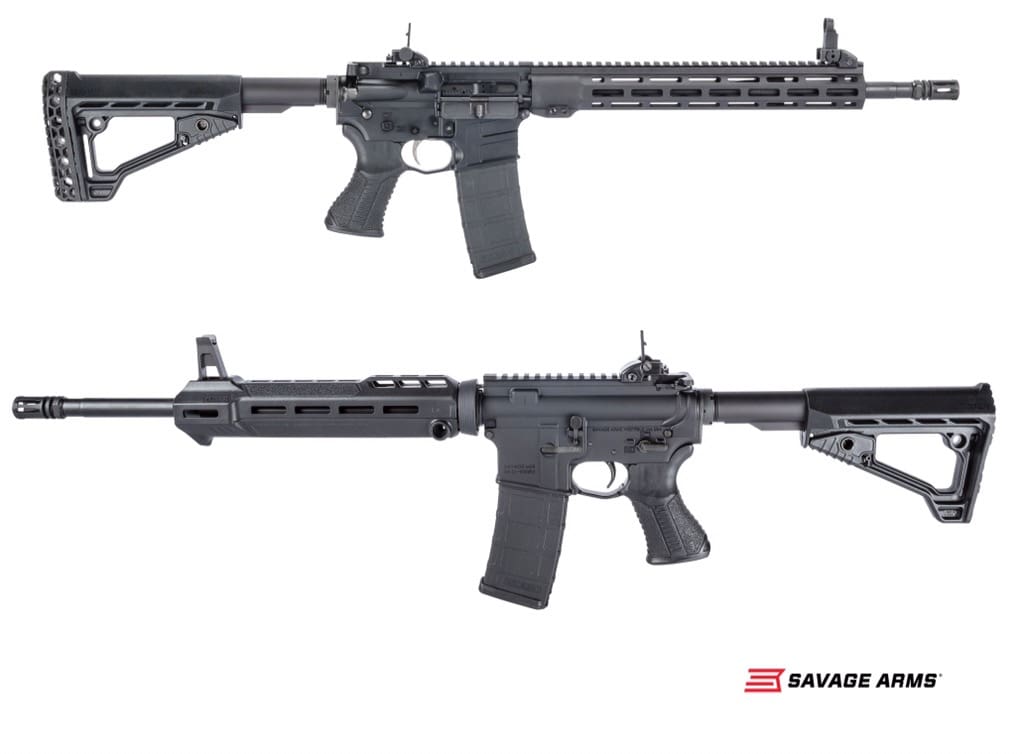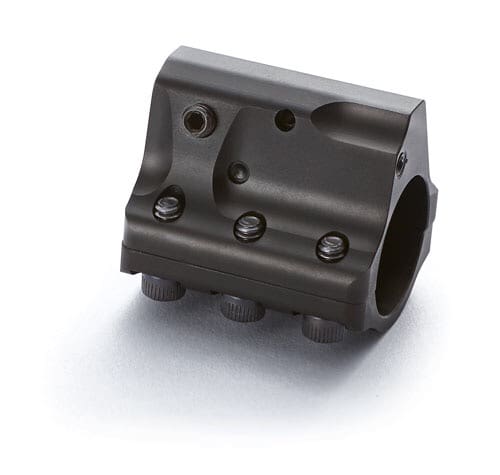He never ceases to surprise me. I just saw Hodge last weekend and he never mentioned it.
Quakertown, PA: Lancer Systems is pleased to announce an update to their SIG516, SIG716, and HK416 OEM-replacement handguards – their M-LOK compatibility. Prior to now, these handguards sported proprietary cooling slots, but now boast more versatility and accesibility. “Customers can look at this as a sign of further developments for Lancer,” comments business area manager Kas McManus. You can check the product out – it will be on display at Lancer’s booth, #3674, during the 2017 NRAAM Show!
Tyrant Designs CNC, an industry leader in high-end aftermarket AR grips, has announced that their top selling line of AR-15 accesories, the AR-15 MOD Grip and MOD ForeGrip will soon (a few weeks to be exact) be available in a nickel finish! This has been rumored to be a limited release only, and will be available on Tyrant’s website as well as a few select distributors.
The MOD Series has made itself popular due to the ability to intermix different sized polymer straps to create a custom fit for each individual’s needs, all while maintaining the ergonomics of a plastic grip with the aesthetics of a wild aluminum grip.
“The amount of inquiries we have had over the past 6 months for a polished MOD Grip has been staggering. We always love listen to our customers and fans, but we did not want to come out with anything less than what we thought was perfect. Polishing was just out of the question due to the man hours involved to polish each grip, and even then it didn’t look great. After lots of trial and error we finally found the perfect combination of media blasting and electroless nickel finish. The process itself is still time consuming and more expensive than our current line of colors, but given the amount of time it has taken for us to get this down perfect we feel we owe it to our customers to release the Nickel Line at the same price point.”
Tyrant Designs CNC is an AR accessories manufacturer based just outside of Chicago. They have had several successful designs for AR pistol grips and are releasing their line of vertical grips and handstops next month.
SPC Joshua Harris, A CO/1-29 Infantry is firing a carbine outfitted with the latest version of the Intelligent Rail or I-Rail, developed by T:Worx, a subsidiary of Prototype Productions.
It is a Picatinny standard, Weapon Accessory Power and Data Rail. Below, you can see an older variant. There is a short cable that runs across the lower receiver to the grip which attaches further to the batteries contained in the collapsible butt stock.
In addition to providing power to weapon accessories, I-Rail is capable of connecting those accessories to the network through the Nett Warrior end user device and Soldier radio.
I-Rail is one of the technologies undergoing evaluation by US and British Army Soldiers during the 2017 Advanced Expeditionary Warfighting Experiment at Ft Benning, GA.
Here is Cpl Craig Gordon, 1st Battalion the Royal Anglian Regiment (The Vikings), moving across a linear danger area during Pilot Mission 1. As you can see, T:Worx has adapted the design to more incorporate more modern features. Gone are the permanent Pic rails at the 3,6,9 and 12 positions.
US Army photos by Angie DePuydt.
This is the English version of the brochure for the new HK433 which was recently unveiled by Heckler & Koch as a contender for the Bundeswehr’s planned replacement for the G36.
The entire brochure can be downloaded from our friends at SPARTANAT.
Hugo, MN – JP Enterprises introduces the solution for poor-fitting AR-15 and AR-10 upper and lower receivers. Loose receivers especially are the bane of most AR builds. This loose receiver fit is annoying and cheapens your rifle but it also limits its accuracy potential. JP MicroFit™ takedown pins bring most receivers up to a rock-hard fit and can dramatically improve even the sloppiest receivers.
Although most poor fitting receivers are loose, some are too tight. Very tight receivers, such as post-Cerakote, can be remedied with the undersized pins.
MicroFit™ pins come in three sizes; mean, oversized and undersized for both the front and rear of the receivers. The mean pins match standard takedown pin sizes while the over- and undersized are offset slightly over .001 from that size. This small variation allows for the small slop or overly tight fit in receivers to be significantly improved. The pins allow for five unique fits, and the maximum loose and tight combinations will significantly change receiver fit.
“We’ve been fighting the issue of poor receiver fit for 20 years, which is when our original Tension Pin debuted,” stated JP Enterprises founder John Paul. “Ask any bolt gun shooter. They will tell you that a rifle loose in its stock will not reach its accuracy potential. An AR with a loose upper/lower is no different. The MircoFit™ pins require no modification to the receiver. They simply replace your current pins.”
MicroFit™ pins are bright polished to a near mirror black finish with a durable QPQ coating. This provides for an ultra-smooth finish and feel with the wear and corrosion resistance of JP’s bolt carriers. All pins feature a two-faceted punch or bullet capturing recess. This allows the user to apply force to the pins safely without risking scratching the receiver.
MicroFit™ pins will be sold as individual pins and as replacement sets. They will be standard on all JP rifles, ensuring a snug fit and pleasing aesthetics.
SUFFIELD, Connecticut – February 3, 2017 – Savage Arms recently announced two models of semi-automatic Modern Sporting Rifles to its popular lineup of high-performance firearms. On the AR-15 platform, the new MSR 15 Recon and MSR 15 Patrol are chambered in 223 Wylde, which enhances out-of-the-box accuracy and allows safe, reliable function with both 223 Rem. and 5.56x45mm ammunition. Both rifles redefine the category with the kind of tack-driving precision and seamless performance you’d expect from a Savage. Shipments are currently being delivered to dealers.

Savage’s new MSR 15 Recon comes standard with upgrades serious shooters demand, including a BLACKHAWK! AR Blaze trigger, free-float handguard and upgraded Savage barrel with a 223 Wylde target chamber. Its 5R rifling and a Melonite QPQ finish ensure the most consistent, accurate performance in any conditions, while the Recon’s custom-forged lower receiver and BLACKHAWK! adjustable buttstock and pistol grip impart a look that stands out from the crowd.
Features:
• Custom forged lower receiver for unique look
• Melonite QPQ 16 1/8-inch barrel with 5R rifling
• 223 Wylde target chamber for use with 223 Rem. or 5.56x45mm
• BLACKHAWK! AR Blaze trigger
• Mid-length gas system
• Free-float M-LOK handguard
• BLACKHAWK! KNOXX AR Pistol Grip and AXIOM Carbine Stock
• BLACKHAWK! flip-up sights
The new Savage MSR 15 Patrol is a step up from the many rack-grade M4 clones popular today. With an upgraded barrel featuring a 223 Wylde target chamber, 5R rifling and a Melonite QPQ finish, the rifle delivers accuracy well beyond mil-spec. A BLACKHAWK! handguard, pistol grip and adjustable buttstock further separate the Patrol from all other MSRs.
Features:
• Mil-spec upper and lower receiver
• 16 1/8-inch barrel with 5R rifling and Melonite QPQ finish
• 223 Wylde target chamber for use with 223 Rem. or 5.56x45mm
• Mil-spec trigger
• Mid-length gas system
• BLACKHAWK! KNOXX AR Pistol Grip and AXIOM Carbine Stock
• Custom A-frame gas block front sight
• BLACKHAWK! flip-up rear sight
Part No. / Description / MSRP
22901 / MSR 15 Recon 223 Rem.-5.56x45mm / $999
22900 / MSR 15 Patrol 223 Rem.-5.56x45mm / $852
Savage Arms is a brand of Vista Outdoor Inc., an outdoor sports and recreation company. To learn more about Savage Arms, visit www.savagearms.com.
Hugo, MN – Offering new options for the underserved market of barrels with .875 gas block journals, JP Enterprises debuts an all-new entry into their line of adjustable gas blocks. The two-piece design of the new JPGS-10D allows for easier installations on barrels with pinned and welded muzzle treatments. At the same time, the new click-adjustable detent system allows for a repeatable setup and secure retention of the gas screw.

The new detent mechanism of the JPGS-10D eliminates the need to access the front of the block for adjustment, which can be an issue when running extended hand guards. Access for adjustment is easily done from the side of JP hand guards. Many other brands of hand guard are also compatible.
In addition to allowing quick and repeatable adjustment increments, the ball detent is captured. Removal of the gas adjustment screw can be done without the worry of losing small parts.
This stainless steel gas block comes on the heels of JP’s existing .750 model (JPGS-9D) with a new .936 version coming out later in 2017.
“We were the first on the market with adjustable gas systems, the first of which we came out with circa 1993,” stated JP Enterprises founder John Paul. “We’ve always seen the tuning of the operating system as crucial to optimizing the function of the rifle overall and cutting down on recoil. These gas blocks elevate that to an entirely new level.”